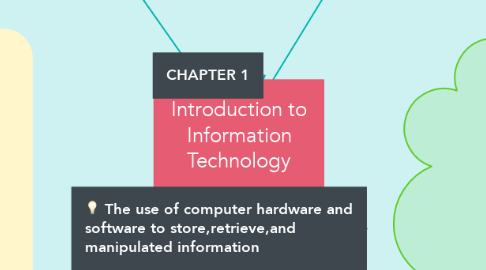
1. Advantages
1.1. speed
1.1.1. data,instruction & information
1.1.1.1. fast speed
1.1.2. process billions or trillions
1.1.2.1. operations in a single second
1.2. Reliability
1.2.1. electronic components
1.2.1.1. dependable & reliable
1.3. Consistency
1.3.1. computer with same input
1.3.1.1. produce same results
1.4. storage
1.4.1. store enormous amounts of data
1.4.1.1. available for processing
1.5. communications
1.5.1. computer communicate wirelessly
1.5.2. users can communicate with others
2. CHAPTER 1
3. Disadvantages
3.1. Health Risk
3.1.1. prolonged or improper computer use
3.1.1.1. eyes injuries
3.2. Violation of Privacy
3.2.1. personal & confidential stored
3.2.1.1. privacy violated & identites stolen
3.2.2. not protected properly
3.3. Public Safety
3.3.1. user share publicly their personal information
3.3.1.1. crimes committed dangerous stangers
3.4. Impact of labour Force
3.4.1. computers replaced many labours
3.5. Impact of Environment
3.5.1. computer manufacturing
3.5.1.1. destroying natural resources
3.5.2. computer waste
3.5.2.1. polluting the environment
4. The use of computer hardware and software to store,retrieve,and manipulated information
5. APPLICATIONS OF INFORMATION TECHNOLOGY
5.1. EDUCATION
5.1.1. Learning management system
5.1.2. computer-based trainning
5.2. FINANCE
5.2.1. Online banking
5.2.2. Finance investment system
5.3. GOVERNMENT
5.3.1. e-filing
5.3.2. e-syariah
5.4. HEALTH CARE
5.4.1. Medline
5.4.2. Telemedicine
5.4.3. Counter Register System
5.5. SCIENCE
5.5.1. Virtual Reality
5.5.2. Hawk-Eye Officiating System
5.6. PUBLISHING
5.6.1. Online Newspaper
5.6.2. Online Photo
5.7. TRAVEL
5.7.1. Global Positioning System(GPS)
5.8. MANUFACTURING
5.8.1. Computer-Aided Design(CAD)
5.8.2. Computer-Aided Manufacturing(CAM)
6. CATEGORIES OF COMPUTER
6.1. Supercomputers
6.1.1. fastest
6.1.2. occupy a full room of equipment
6.1.3. tens thousand of processors
6.2. Mainframes
6.2.1. faster
6.2.2. occupy partial to a full room of equipment
6.2.3. dozens of processors
6.3. Personal Computers
6.3.1. fits on a desk
6.3.2. exp:desktop computer
6.4. Mobile Computers
6.4.1. fits on your lap or in your hand
6.4.2. can carry from place to place
6.4.3. exp:notebook computers
6.5. Mobile Device
6.5.1. fits in the palm or pocket size
6.5.2. exp:smart phones
6.6. Embedded Computers
6.6.1. Miniature
6.6.2. functions as component in larger product

